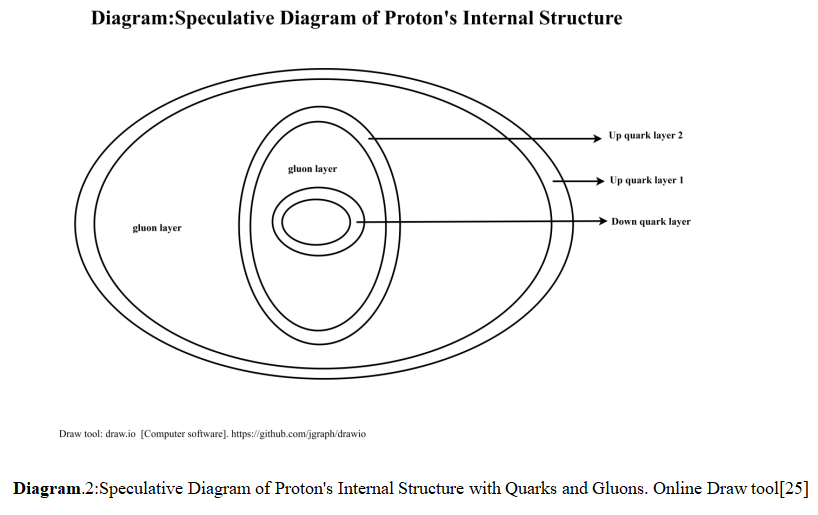Gauge Mediating Mass-Gravity
10. Mass, Gravity, SU(3) and Higgs field in Quantum Field Theory
10.2 U(1): Electromagnetic Interaction
10.3 SU(2): Adjustments of Rotational Axes,spin and encoding chirality in Charged Microscopic Particle Structural Matrices.Encoding Rotational chirality of Charged Microscopic Particle Structural Matrices as the Origin of Weak Interaction Symmetry Breaking. because the rotational Structural Matrices with different chirality have different coupling mode with the fixed chirality of SEQ's ground-state spin. Although SU(2) lacks a chirality modulation parameter, its definition as adjusting rotation axes and spin for charged particles with specific chirality intrinsically encodes chiral variables.
10.4 SU(3): Note:The phase in SU(3):compression or stretching shift between SEQ.
10.4.1 Imagine the 3D dynamic quasi-spherical matrix structure of quarks as a multi-layered and multi-axial rotational configuration. Due to the high-energy concentration within the structure, the SEQ within the structure remain in a dynamic equilibrium of compression or stretching, while the interactions between layers also maintain a dynamic equilibrium of compression or stretching.
10.4.2 Fractional quark charges emerge from stratified SEQ layers in proton/neutron matrices, with 2/3-charged quarks occupying twice the layers of 1/3-charged quarks. The multi-layered structure well explains the observed differences between high-energy(uniform angular distribution) and medium-energy regimes in electron-proton scattering experiments.
10.4.3 The color property of quarks corresponds to the long axis of their dynamic structural matrix, specifically the axis with the highest energy density distribution within the quark's structural configuration. The color neutrality of protons and neutrons corresponds to the global spatial symmetry, the isotropy of the electric field(protons) and structural stability exhibited by their spatial structural matrices.
10.4.4 Antiquarks correspond to the handedness reverse representation of structural matrix rotational transformation of their corresponding quarks.
10.4.5 The 8 generators of SU(3) correspond to 8 distinct interactions mediated by different gluons. Among them, the 6 non-diagonal matrices represent combinations of color exchange operations, stretching and compression phase transformations with phase variations(3*2); while the 2 diagonal matrices correspond to scaling transformations across the three color dimensions. These gluons and their 8 distinct interaction types operate within the interlayer regions of the multi-layered structural matrices of protons or neutrons.
The dynamic color exchange corresponding to the generators of SU(3) and the three-dimensional color distribution modulation are fundamentally linked to the translational action of gravity. Therefore, the color modulation and exchange interactions of SU(3) could constitute one of the origin of mass.
10.4.6 Gluons mediate compression and tensile stresses between quarks or interlayer SEQ. Gluons can be understood as a kind of quasi-structure of rotational highly condensed SEQ, akin to a high-density array of springs.
10.4.7 Quark asymptotic freedom and color confinement originated from nonlinear variations in compression-tensile tensions among SEQ.
10.4.8 The three-quark point-like configuration inherently fails to achieve spatial symmetry, contradicting the observed spherical charge distribution of protons, whereas this hypothesis of a layered arrangement in a quasi-spherical structure of up and down quarks within the proton offers a more plausible explanation for the integer charge of the proton and the isotropic nature of the electric field as well.
10.4.9 The discrepancy in the proton's g-factor from theoretical models stems from an underestimation of the gluon field's spinor contribution. If the effect of the rapidly rotating gluon field were properly accounted for, this deviation would significantly diminish. Moreover, the conventional three-point-quark distribution framework fundamentally cannot accommodate a proportionally substantial gluon field spinor component. The layered structure proposed in this model presents a viable architectural framework worthy of serious consideration.
10.5 How SU(3) Generators Mediate Mass Formation
They compress local space while performing 3D modulation, axis transformations, and compression-phase adjustments to ensure the compressed space remains approximately spherically symmetric. As a result, the gravitational field generated by mass (the stretching of external space due to local compression) is also spherically divergent, guaranteeing the isotropy of mass-induced gravity. The physical picture is now clear.


